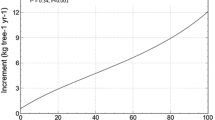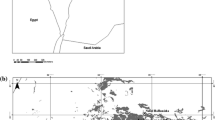Abstract
Data from the second half of a 14-year study of a eucalypt dry sclerophyll forest invaded by Pinus radiata D. Don shows further progress in the development of a mixed eucalypt-pine stand. Earlier (Chilvers and Burdon 1983) it was clear that pines invading from an adjacent commercial plantation were starting to contribute their own progeny to the mixed stand. Initially the recruitment of established pines (> 1 m high) from these seedlings was very slow. However, since 1984, increasing numbers of seedlings have survived beyond their first year, suggesting the possibility of another wave of successful establishment in the near future. The established fraction of the pine population continued to grow rapidly and incurred no mortality. Many of these plants have now emerged through the top of the eucalypt canopy. In contrast, both juvenile and adult eucalypt numbers continued to decline. Despite these demographic and visual changes, comparative analysis of the growth of established pines over two consecutive 7-year periods (1974–1981; 1981–1988) showed that competition between neighbouring plants, especially pines, is beginning to affect individual growth rates. Growth rates of pines having other pines as nearest neighbours declined 40% between 1974–1981 and 1981–1988, while that of pines with eucalypts as nearest neighbours fell by 28%. In pine-pine nearest neighbour (NN) pairs, growth rates were significantly affected by the size (diameter) of the nearest neighbour. In pine-eucalypt NN pairs growth rates of the pines were not affected by the size of the eucalypt, but these were significantly negatively correlated with the inverse of the distance to the eucalypt. More broad-based assessment of 43 pines showed a significant relationship between their growth rates and the summed competitive effect of other pines within a 5-m radius. No such relationship was found between growth rate and the summed competitive effect of eucalypts in the 5-m zone.
Similar content being viewed by others
References
Burdon JJ, Chilvers GA (1977) Preliminary studies on a native eucalypt forest invaded by exotic pines. Oecologia 31:1–12
Chilvers GA, Burdon JJ (1983) Further studies on a native Australian eucalypt forest invaded by exotic pines. Oecologia 59:239–245
Dawson MP, Florence RG, Foster MB, Olsthoorn A (1979) Temporal variation of Pinus radiata invasion of eucalypt forest. Aust For Res 9:153–161
Minko G, Aeberli BC (1986) Spread of radiata pine into indigenous vegetation in north-eastern Victoria. Department of Conservation and Lands, Victoria. For Techn Pap 30:17–25
Richardson DM, Bond WJ (1991) Determinants of plant distribution: evidence from pine invasions. Am Nat 137:639–668
Richardson DM, Brown PJ (1986) Invasion of mesic mountain fynbos by Pinus radiata. S Afr J Bot 52: 529–536
Sommem FJ van der (1978) The colonization by Pinus radiata D. Don of eucalypt dominated communities in South Australia. M.Sc. Thesis, University of Adelaide, Adelaide
Weiner J (1984) Neighbourhood interference amongst Pinus rigida individuals. J Ecol 72:183–195
Author information
Authors and Affiliations
Rights and permissions
About this article
Cite this article
Burdon, J.J., Chilvers, G.A. Demographic changes and the development of competition in a native Australian eucalypt forest invaded by exotic pines. Oecologia 97, 419–423 (1994). https://doi.org/10.1007/BF00317334
Received:
Accepted:
Issue Date:
DOI: https://doi.org/10.1007/BF00317334




